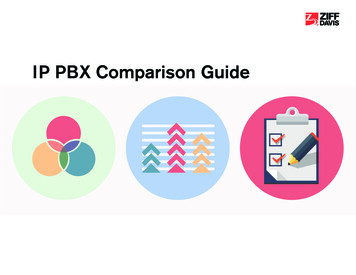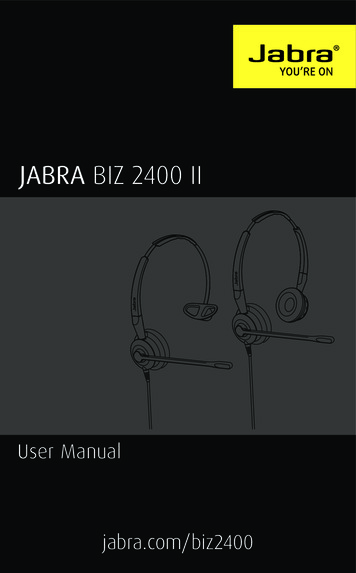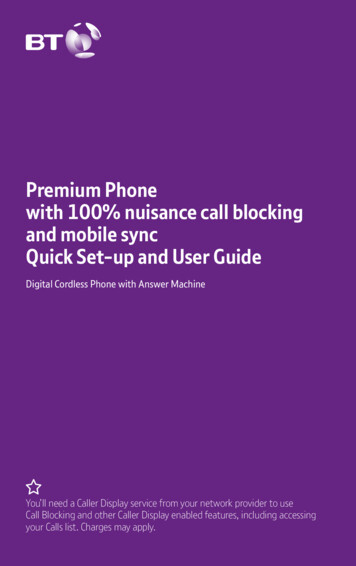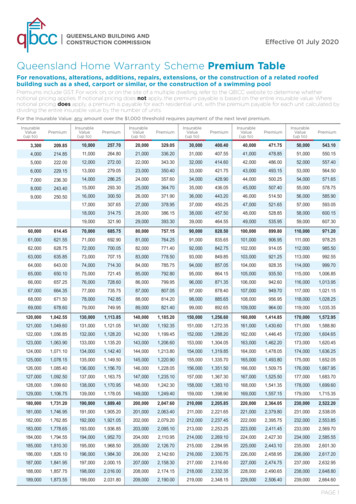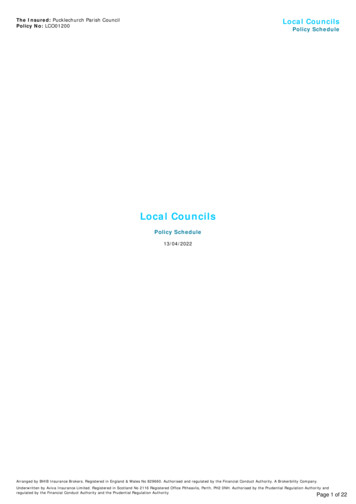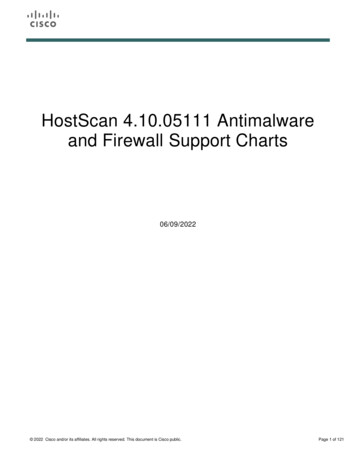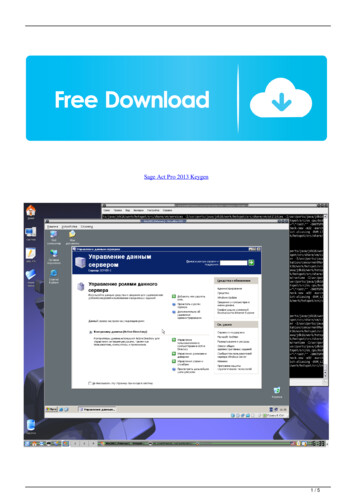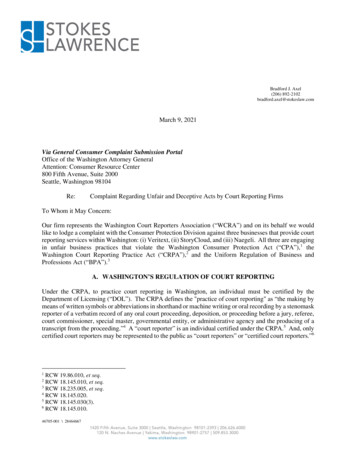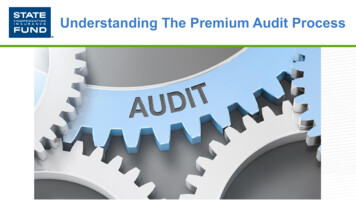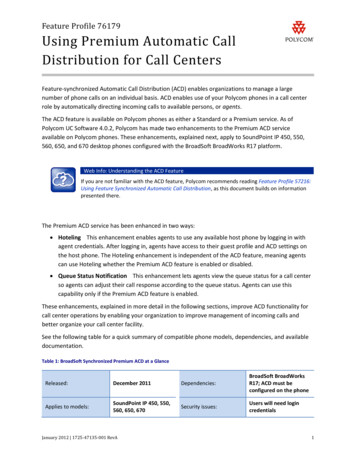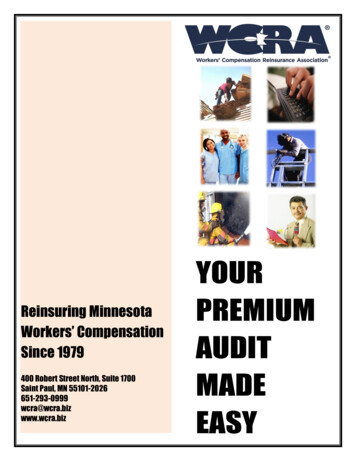
Transcription
Reinsuring MinnesotaWorkers’ CompensationSince 1979400 Robert Street North, Suite 1700Saint Paul, MN RPREMIUMAUDITMADEEASY
At the WCRA, we want to make thepremium audit process easy foryou.That is why we created this step-by-step guideas a tool for you to successfully prepare foryour WCRA premium audit. This brochurewill take the guesswork out of the auditprocess and explain why a premium audit isnecessary for both the WCRA and yourorganization. The checklist included with thisguide identifies the majority of documents aWCRA auditor might need from you tocomplete the audit. It will also help youorganize your records in preparation for theaudit.Page 1What is a premium audit?A WCRA premium audit is simply a means ofreviewing a member’s records and operationsto ensure that the coverage information isaccurate and complete. The goal of the audit isto calculate your organization’s exposure inorder to true-up premium paid from estimatedto actual—no more and no less.Why is a premium audit necessary?Premium for new members is calculated basedon the projected payroll information received,and premium for existing members iscalculated based on aged data from the lastaudit period. In order to ensure that yourorganization pays the correct premium for thecoverage received, a WCRA auditor willcompare the payroll that was projected at theinception of your policy to the actual payroll atthe end of the policy term. Each policy termmay be field-audited or the WCRA may relyon the annual adjustment self-audit dataelectronically submitted by each memberannually.
There are three types of auditsconducted by the WCRA.How do I prepare for a premiumaudit? Annual Adjustment Self- Audit: Members See the premium audit checklist on page 7 ofthis brochure for a complete itemized list ofare required annually to submit datarecords needed during an audit.through the WCRA annual adjustmentreporting site. This information allowsWCRA staff to true-up premium fromestimated to actual. Physical Audit: These audits are generallyconducted on-site with the member andWCRA auditor every three years. Auditsare scheduled with the member at theexpiration of the policy year or cancellationof their membership. Interim Audit: These audits are generallyconducted on-site with the member andWCRA auditor during the course of thepolicy term. Interim audits are used toadjust a policy to reflect significant changesin business operations and/or payroll duringthe policy term. They are also conductedwhen a member requests (and is approved)to be considered a “hybrid” member.Hybrid members are usually trusts, groupself-insurers, etc. which are typicallyaudited on an annual basis due to thecomplexities of the hybrid member’sstructure.The WCRA reserves the right to determine themethod and frequency of premium audits.How should my payroll records beorganized for an audit?In order to collect the specific payrollinformation needed to conduct an accuratepremium audit, please have your payrollrecords organized in the following manner. Policy Term: The only records needed arethose that reflect payroll for the policy termrequested by the premium auditor. Classification: List each type of jobseparately (e.g., clerical, sales, etc.)according to the Minnesota Workers’Compensation Insurers Association(MWCIA) job classification codes. Jurisdiction: The WCRA providescoverage solely for Minnesota, so onlyrecords covering Minnesota employmentand exposure are required. Overtime: These records should reflectovertime paid to employees during thepolicy term.Page 2
Who is considered an officer orofficial? Why is this important?What is considered payroll?What is considered remuneration?Payroll is the total amount of money paid toemployees during a given time. Remunerationis the payment for goods received, servicesrendered, or losses incurred. The followingrecords are required for both payroll andremuneration during a premium audit.Officers of a corporation or unincorporatedassociation are the president, vice president,secretary, treasurer, or any other officerappointed in accordance with the charter orbylaws of the entity. In general, officers areautomatically included for coverage inMinnesota except certain officers of closelyheld corporations. Officers of closely heldcorporations who are automatically excludedmay elect to be covered under the law.Self-insured members from public entities withelected and appointed officials are eligible forcoverage. Records will be needed if thegoverning body of the political subdivision hasadopted an ordinance or resolution indicatingthe entity’s intent to cover elected and/orappointed officials. Employee wages. Overtime. Commissions and bonuses, as well asholiday, vacation, and sick pay. Tax-deferred payments such as cafeteriaplans, 401(k) plans, etc. Car or tool allowances (other thanreimbursements). Insured sole proprietors, partners, officers,and/or public officials. Uninsured subcontractors. Actual expenses and miscellaneous labor.Page 3It is important to identify officers and officialsbecause payroll for these groups of individualsis included in the payroll reported for thecalculation of premium subject to annualminimum and maximum payroll valuelimitations annually set by the MWCIA.These limitations typically reduce the amountof payroll included in the calculation ofpremium.
What if employees work in morethan one classification?What do I need to know aboutsubcontractor payroll?In general, the WCRA assigns one basicclassification that best describes your business.However, certain classes known as “standardexceptions” may be broken out, such asclerical workers, sales staff, drivers, etc.For each subcontractor you hire who does notprovide evidence of workers’ compensationinsurance, additional premium must becharged on the contractor’s policy for theuninsured subcontractor’s employeesaccording to Subcontractor Tables 1 and 2In the construction trade, members are allowed below.to break out payroll among the various trades.For example, HVAC contractors may breakSubcontractor Table 1out plumbing separately from electrical wiring.The breakout, however, must be a verifiableIf the contractor has not furnished evidence oftime breakout; percentages are not allowed.workers’ compensation insurance andIt is the member’s responsibility to keeppayroll records on a time basis and to be surethat the hours in each classification areaccurately tracked. Although the breakoutmethod may require additional recordkeeping,it is advantageous to the member because theWCRA auditor will assign all earnings to theclassification with the highest rate if themember does not maintain a payroll breakout.In either case, these records should be kept forauditing purposes.Please contact Jim Sanem at 651-229-1809 orj.sanem@wcra.biz with questions regardingjob classification codes.Page 4a) furnishes complete payroll records of thesubcontractor’s employees, the detailedpayroll records will be used to calculate thepremium.b) does not furnish complete payroll records,and the subcontractor price does not reflecta definite payroll amount, the fullsubcontract price of the work performedduring the policy period by thesubcontractor will be used to calculatepremium.c) does not furnish items listed in a) and b) butdoes provide documentation of a specificjob that discloses that a definite amount ofthe subcontract price represents payroll, thepayroll amount designated on thedocumentation (subject to the minimums inSubcontractor Table 2) will be used tocalculate premium.
Subcontractor payroll? (continued)Vehicles with drivers, chauffeurs, or helperswho are entitled to benefits under workers’compensation insurance law may be engagedunder verbal or written contract. The amountused to calculate the premium is based on theinformation available. If payroll can be obtained, the total must beincluded with the member’s payroll.Subcontractor Table 2 If payroll cannot be obtained, 25 percent ofthe total contract price for the vehicle mustbe included on the member’s payroll.a) If the job involves mobile equipment with If the contract price does not include theoperators (such as, but not limited to,cost of fuel, maintenance, or other servicesearthmovers, graders, bulldozers, etc.), thenprovided to the owner under the contract,the minimum used to calculate additionalthe value of these goods and services mustpremium is not less than 25 percent of thebe added to the contract price beforesubcontract price.determining the 25 percent amount.b) If the job involves labor and material, thenthe minimum used to calculate additionalpremium is not less than 50 percent of thesubcontract price.c) If the job involves labor only, then theminimum used to calculate additionalpremium is not less than 90 percent of thesubcontract price. If a subcontractor claims to be insured,obtain an original version of the Workers’Compensation Certificate of Insurance. Awritten statement from the subcontractor isnot adequate proof of coverage.Keep original Certificates of Insurance (notphotocopies) on file, as WCRA auditors willreview them during the audit. Be sure that theperiod of coverage on the Certificate matchesd) If the job involves piecework, thenas closely as possible with the period when the100 percent of the subcontract price is used work was performed.to calculate additional premium.Page 5
Be available for questions.The owner of the business should be accessibleto speak with the WCRA auditor to answerquestions and review the results of thepremium audit. If the owner is not available atthe time of the audit, the auditor will need tomeet with someone (e.g., director or divisionmanager) who has a thorough knowledge ofthe business operations.Audit results and confidentiality.All information obtained will be kept in strictconfidence and used by WCRA staff for thepurpose of the audit. You will receive an auditreport from the WCRA shortly after thepremium audit is completed.Page 6What if I disagree with the resultsof the premium audit?If you disagree with the results of your audit,you may formally dispute the audit byproviding written documentation regardingyour specific issues or concerns. Fax yourdocument to 651-229-1818 or mail it to:WCRAPremium Audit DepartmentSuite 1700400 Robert Street NorthSaint Paul, MN 55101
Your premium audit checklist.Refer to this checklist to assist you ingathering the necessary records for yourphysical premium audit. Please makeavailable all records for the policy year(s)indicated by the WCRA auditor. Theserecords include: Minnesota unemployment returns. Federal form 941 or 943. Federal form 940. Federal form 1099, W-2, and W3transmittals. Individual payroll records including abreakout of any overtime. Benefit plan information such as cafeteriaand/or 401(k) plan wages. List of corporate officers including names,job titles, and wages. General ledger, check register, and/or cashdisbursements. Verifiable payroll breakdown forconstruction classification. Sales and cash receipts journals. Contractor and subcontractor records. Certificate of workers’ compensationinsurance for all subcontractors. Job cost records, contracts, and workinvoices showing type of work performed.Page 7Questions? Call us!If you have any questions concerning yourpremium audit, please contact Jim Sanem at651-229-1809 for assistance. Or you may callthe WCRA toll-free at 800-293-8006 and press3 to reach the premium department.Additional information is also available on theWCRA website.www.wcra.biz
premium audit, please contact Jim Sanem at 651 -229 1809 for assistance. Or you may call the WCRA toll -free at 800 293 8006 and press 3 to reach the premium department. Additional information is also available on the WCRA website. www.wcra.biz. Author: Cindy M. Smith Created Date:
